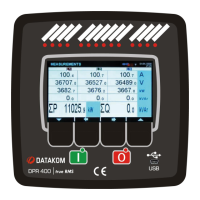Table 9.1
If any of the phase currents exceeds the configured threshold value, the function begins calculating the
trip time using the given parameters. This output trips the breaker at the end of the configured time,
according to constant time (DT) or variable inverse time (IDMT).
There are 4 levels of configuration parameters for overcurrent. This allows for configuring different trip
timers for different input currents. For example, level 1 (I>) can be used for overcurrent protection, while
level 2 (I>>) can be used for short circuit protection with sudden trip (constant time (DT) and trip timer set
to 0).
The controller allows directional protection for overcurrent. It can be used for single directional protection,
or level 1 (I>) protection may be programmed for forward directional protection while level 2 (I>>) can be
configured for reverse directional protection.
The controller continuously measures the negative sequence current component and provides 4 levels of
optionally directional protection. Constant time (DT) and variable time (IDMT) protection curves identical
to the overcurrent protection are available.
Negative component protection provides protection from unbalanced loading. In particular, generators
can handle only a certain amount of unbalanced loading. Generators must be broken from the circuit in
case of an extreme unbalance. In case of unbalance, the symmetry of stator currents is broken and a
negative current component in the opposite direction begins to flow. These negative current components
cause extra heating along with mechanical problems such as rotor vibrations.

